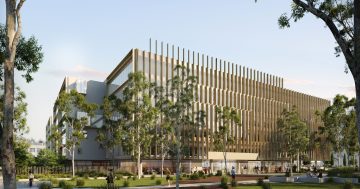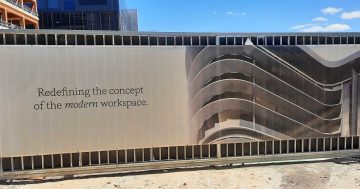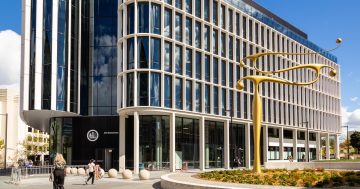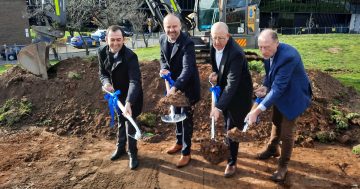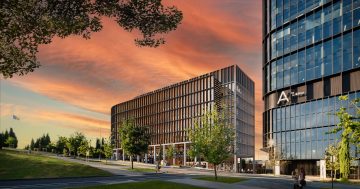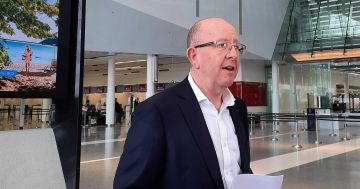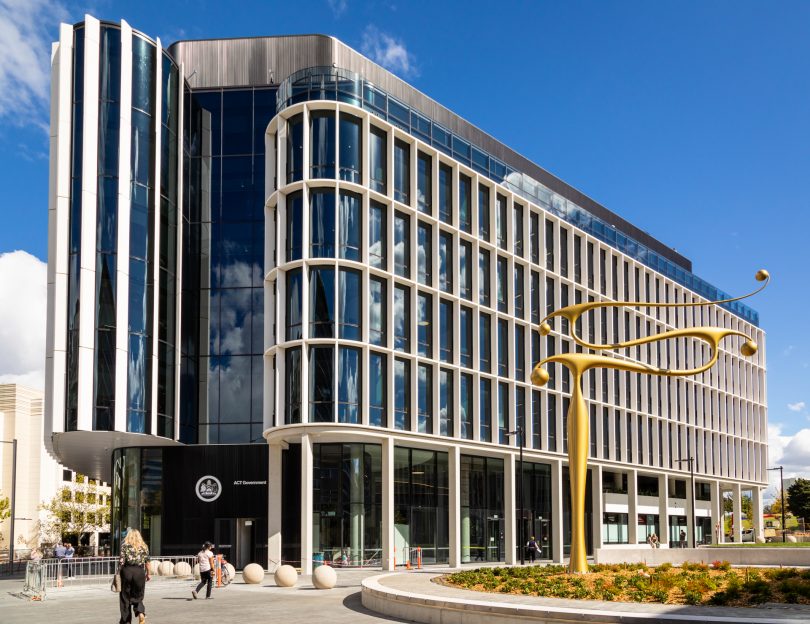
The ACT Government building in Civic is already adapting to the new COVID-19 environment. Photo: Michelle Kroll.
The office may never be the same after COVID-19. Not only is the hybrid workplace likely here to stay, but the layout, fitout and facilities of the traditional office are going to have to change.
Canberra’s COVID-19 lockdown has hit the national capital’s office occupancy worse than other Australian cities, plummeting from 73 per cent to 8 per cent of pre-COVID occupancy, according to the ACT Property Council.
That’s understandable given the ACT’s large government workforces and the number of big companies and national organisations set up in town to be close to government.
Unlike the COVID-19 lockdown in 2020, the shift to working at home this time around was relatively seamless, according David Schmidtchen from Canberra consultancy Synergy.
He said the patterns of work had already been learned and many of the issues such as with technology had been sorted out.
The next big step will be when restrictions ease at the 80 per cent vaccination threshold and we see how the workplace landscape has changed.
Mr Schmidtchen said the past 18 months has been learning experience in which both workers and managers have had to adapt, and working from home has been legitimatised. For many, the future will be a mix of home and office work.
“The hybrid workplace is here to stay,” he said. “We’ll be looking for more permanent solutions and habits around hybrid working, and that’s where the real change will take place.”
The new ACT Government offices in Canberra City and at Dickson have already adopted a hybrid or flexible working model, with reduced capacity for overall staff numbers and more meeting spaces.
However, Mr Schmidtchen said the office will remain important from a cultural, social-connection human perspective, as well as for innovation and collaboration, and these may become the main reasons for going to the office.
“The possibility is that hybrid working opens up a different way for us to think about why the office exists in the first place,” he said.
Mr Schmidtchen said the internal layout and design of offices may have to change from activity based work at a desk to cater for that different purpose.
It will be a time of reassessment for the property industry about the office’s role in helping people to work effectively and productively, and how it can be a better work environment.
“We might see fitout be more modular and flexible so we can adjust the internal office design to suit our evolving nature of work,” said Mr Schmidtchen.
“What if property was designed to maximise productivity rather than space?”
He said how social connection – which is so important to performance and productivity – is accommodated in the hybrid workplace is going to be a key question for not only leaders of organisations but employees, too.
In fact, leaders are likely have to evolve and innovate to deal with a greater diversity of work settings.
“Maybe that’s where we need to focus our efforts rather wringing our hands about whether employees are watching Netflix at home,” said Mr Schmidtchen.
For the property industry, the emptying of CBDs and the questioning of the very need for offices has been traumatic.
In Canberra, office demand and investment enquiries pre-lockdown were strong, and while there is pipeline of new buildings in the city and close to Parliament House, the current situation is parlous.
ACT Property Council executive director Adina Cirson said property income has been halved and the enquiry rate for new leases has fallen through the floor.
But importantly, the Commonwealth is still looking for more space, which is vital in a town where the public service represents more than 50 per cent of the office market.
A lot of pent-up demand is expected in the new year, when hopefully the COVID-19 pandemic recedes in the face of mass vaccination and lifted restrictions.
Ms Cirson said it will be crucial for CBD economies for workers to return, and employers, governments and developers will be thinking hard about how to do that.
“I think employers realise that if they are going to get people back into the office, which is where they need them to be if they’re going to most productive and efficient, they need to make their workplaces more attractive,” she said.
Ms Cirson doesn’t believe office buildings will become smaller. On the contrary, new product is likely to reflect the need to be capable of social distancing with more space, not less, and incorporating features such as contactless lift points.
A joint report from the Property Council of Australia and EY, ‘Reimagining Our Economic Powerhouses: How to turn CBDs into central experience districts’, calls on governments, employers and property owners to work together to improve the vibrancy of CBDs.
It suggests initiatives such as free public transport and parking, expanding green space and activating precincts to create ‘central experience districts’, as well as reimagining unused space by filling empty floor space with pop-ups that add vibrancy.
But the report also acknowledges that the hybrid workplace is likely to continue, finding that 70 per cent of Australian CBD workers would like to continue working flexibly at least some of the week, with 3.3 days in the office the preference.
Ms Cirson said there had been a dip in the numbers of workers in the office on Mondays and Fridays, and there had been campaigns emphasising social connection such as FOMO (fear of missing out) and Fabulous Fridays, and city events to lure them back, at least at the end of the working week.
She said there is a strong economic imperative to get people back in their offices.
“Tenants, retailers, hospitality, hairdressers, all those [for example] at the base of a big Commonwealth building suffer when they haven’t got their regular trade,” said Ms Cirson.
That may be so, but all agree that times have changed and that returning to a pre-COVID-19 normal is unlikely.
“Is the office dead? No, God no,” said Mr Schmidtchen.
But it is evolving, and that process has a way to play out.












